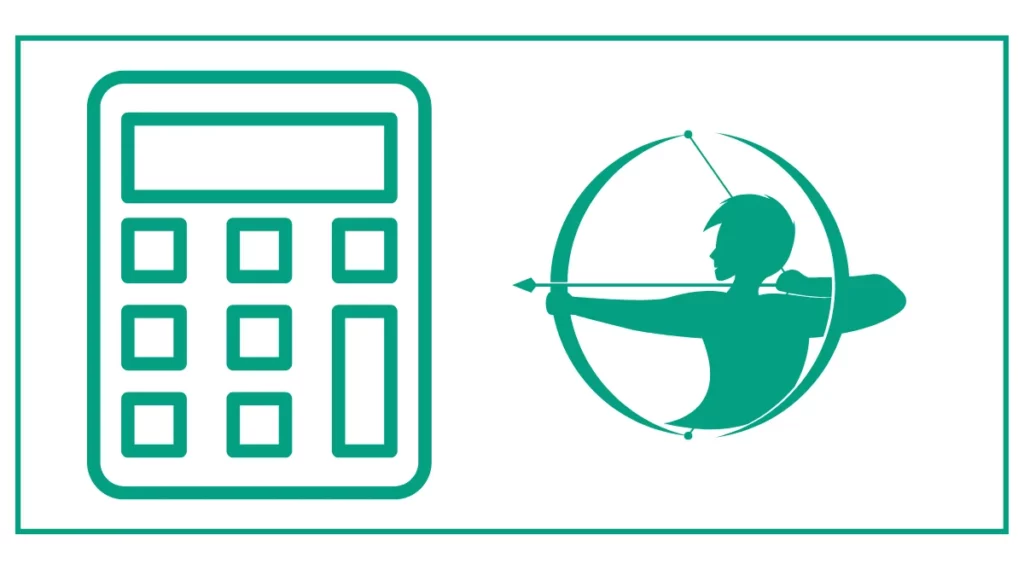FOC Calculator (Front Of Center)
This FOC calculator helps you calculate the percentage of the front of the center of your arrow.
Enter your arrow length and the balance point to find the FOC%.
Simply put, FOC is the arrow’s front half weight. It matters to those competing in 3-D and FITA Archery contests when shots are long, and competition is severe.
Perfect FOC % improves arrow performance and accuracy.
Good F.O.C. percentages improve accuracy and penetration.
More weight in the front portion of the arrow increases the first wallop.

You might want to calculate ape index or might want to determine your passer rating.
What is FOC (Front of Center)?
FOC, which stands for Front of Center, is a critical measurement in archery that refers to the percentage of an arrow’s total weight that is located in the front half of the arrow. This balance point is crucial for arrow flight stability, accuracy, and overall performance.
Understanding and optimizing FOC can significantly improve an archer’s shooting experience and results, particularly in long-range shooting and competitive scenarios.
The Importance of FOC in Archery
FOC plays a vital role in arrow dynamics for several reasons:
- Flight Stability: A higher FOC percentage generally results in a more stable arrow flight, as the weight distribution helps maintain the arrow’s trajectory.
- Wind Resistance: Arrows with optimal FOC are less affected by crosswinds, making them more accurate in outdoor shooting conditions.
- Penetration: A higher FOC can improve an arrow’s penetration power, which is particularly beneficial for bowhunting.
- Accuracy: Proper FOC contributes to better accuracy, especially at longer distances, by helping the arrow maintain its course.
- Broadhead Performance: For hunters, the right FOC can enhance broadhead performance and ensure consistent flight characteristics between practice points and hunting tips.
How to Measure FOC
To calculate FOC, you need two key measurements:
- Arrow Length (A): The overall length of the arrow, measured from the throat of the nock to the end of the shaft (excluding the point).
- Balance Point (B): The point where the arrow balances when placed on a narrow edge, measured from the throat of the nock to this balance point.
Using the FOC Calculator
Our FOC Calculator simplifies the process of determining your arrow’s FOC percentage. Here’s how to use it:
- Enter the Arrow Length (A) in the first field.
- Enter the Balance Point (B) in the second field.
- Click the “Calculate F.O.C %” button.
The calculator will then display your arrow’s FOC percentage.
Understanding FOC Percentages
FOC percentages typically fall within the following ranges:
- 7-9%: Considered low FOC, suitable for indoor target archery or very short-range shooting.
- 9-11%: Standard FOC for most target archery applications.
- 11-15%: High FOC, often preferred for outdoor target archery and hunting.
- 15%+: Very high FOC, used in specialized long-range archery or extreme condition hunting.
Factors Affecting FOC
Several factors can influence an arrow’s FOC:
- Arrow Length: Longer arrows generally have lower FOC percentages than shorter arrows of the same weight distribution.
- Point Weight: Heavier arrow points increase FOC.
- Shaft Material: Different materials (carbon, aluminum, wood) have varying weight distributions.
- Fletching: Heavier fletching at the rear of the arrow decreases FOC.
- Insert Weight: Heavier inserts increase FOC.
- Nock and Nock Bushing Weight: Heavier components at the rear decrease FOC.
Optimizing FOC for Different Archery Disciplines
Target Archery
For target archery, especially indoor competitions, a lower FOC (around 7-11%) is often preferred. This setup allows for a flatter trajectory over shorter distances, which can be beneficial in controlled environments.
Example: A target archer using a 30-inch arrow with a balance point at 19 inches would have an FOC of about 13.3%. This might be slightly high for indoor target archery, so the archer could consider reducing point weight or using lighter inserts to bring the FOC closer to the 9-11% range.
Field Archery and 3D Archery
These disciplines often benefit from a slightly higher FOC (11-15%) due to the varied shooting conditions and distances encountered. The increased stability provided by a higher FOC can help maintain accuracy across different terrains and wind conditions.
Bowhunting
Bowhunters often prefer higher FOC percentages (12-15% or even higher) for improved penetration and broadhead performance. The additional front weight helps the arrow maintain momentum upon impact.
Example: A bowhunter using a 28-inch arrow with a balance point at 18.5 inches would have an FOC of about 16.1%. This higher FOC could provide excellent stability for broadhead flight and improved penetration on game animals.
Adjusting FOC
If you find that your arrow’s FOC is not optimal for your shooting style or discipline, there are several ways to adjust it:
- Change Point Weight: Using heavier or lighter points is the most common method of adjusting FOC.
- Adjust Arrow Length: Shortening arrows can increase FOC, while lengthening them can decrease it.
- Modify Insert Weight: Heavier inserts increase FOC, while lighter ones decrease it.
- Alter Fletching: Lighter fletching or reducing the number of vanes can increase FOC.
- Change Nock Components: Lighter nocks and bushings can slightly increase FOC.
The Impact of FOC on Arrow Speed
It’s important to note that increasing FOC often comes at the cost of arrow speed. As you add weight to the front of the arrow, the overall arrow becomes heavier, which can reduce its velocity. However, the trade-off is often worthwhile for the improved stability and accuracy, especially at longer ranges.
FOC and Arrow Spine
When adjusting FOC, it’s crucial to consider arrow spine. Spine refers to the arrow’s stiffness and its ability to resist bending during the shot. Changes in FOC can affect the arrow’s dynamic spine, potentially requiring adjustments to maintain proper arrow flight.
As a general rule:
- Increasing FOC may require a stiffer spine
- Decreasing FOC may allow for a slightly weaker spine






